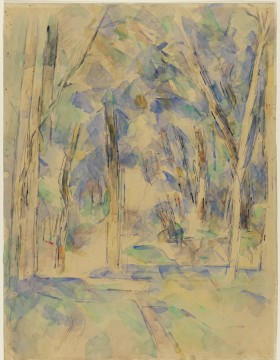Trees Forming an Arch (Arbres Formant une Voûte)
Provenance
[Ambroise Vollard (1867–1939), Paris]. Private collection, Germany. Paul Brame (1898–1971), Paris. Henry Pearlman, New York, by 1959; Henry and Rose Pearlman Foundation, after 1974.
Conservator's Note
Evident from the many tackholes around the edges and in the corners, it is likely that Cézanne worked on this watercolor in several stages, allowing the moist strokes to dry completely before overlapping them with additional strokes of translucent paint.
Critical Perspective
One of a number of Cézanne's double-sided watercolors. On the recto: This watercolor is thought to depict a scene in or near the forest of Fontainebleau, near Paris, where Cézanne spent part of the summers of 1904 and 1905. Although he clearly sketched the scene before beginning to paint, and later reworked part of the composition in graphite, Cézanne’s many layers of watercolor predominate.
verso: Sketches of rooftops are rare in Cézanne’s work, and, when they do occur, the angular roofs and vertical chimneys are almost always set in contrast to trees or in the context of a landscape. In this monochromatic watercolor, which may have been executed in Paris, the absent foliage is conveyed by the curving scrollwork, clearly differentiated from the slanting roofs by the horizontal rail.

